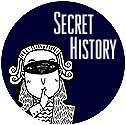
Comment
on this story |
 |

A theory about that house on Speedway Circle
by Jack Neely
In deep East Knoxville, there's a perfectly oval street, about half a mile in circumference. It's called Speedway Circle, and it's well-named. A century ago, gentlemen made bets on thoroughbreds at Cal Johnson's famous old horse-racing track here. It's named for the old racetrack because it is the old racetrack. Early in the last century, after horse-racing was banned here, some enterprising developer paved the old track, and folks began planting houses on it.
Now a quiet residential neighborhood, Speedway Circle is a Knoxville curiosity, a place people take visitors to show them something distinctly Knoxvillian. Most of the houses are modest in size, and date from the middle of the 20th century. There's one that stands out from the others. Taller than it is wide, it's a town-style house on the infield side of the racetrack, near the eastern turn: a two-story brick place with an unusual marble facade, and columns on the front. On the side there's a small marble lion's head, and windows on three levels, one of stained glass. It sticks out for several reasons; it's the biggest house on Speedway Circle, and it looks like the oldest. The architecturally most-elaborate house in the neighborhood appears to date from the Victorian era, which was also the era of this racetrack. That quandary has led some to the conclusion that the building was here in the infield during the racetrack era.
It's vacant now. It looks a little askew, bent in places, and bolted together.
The most unusual thing of all is the number carved into the marble lintel: 918. That wouldn't seem particularly odd, except that this house's street address is 3738. I asked my preservationist colleague Matt Edens about it; he takes it for a late-19th-century house. He says he once saw a house that looked just like it in an old picture of Gay Street. He thinks someone moved it here from downtown.
I didn't say so, but that seemed pretty fishy to me, that someone would take a big brick-and-marble townhouse and move it several miles out here and somehow put it back together on a racetrack. To prove him wrong, I took that mysterious number and went to the city directories. As it turns out, 918 was a residential address on Gay Street, and it was the home of Joseph Knaffl.
I don't know how familiar that vowel-challenged name is to you, but I get an e-mail about it every week or two. Metro Pulse gets around more than it has any right to. There are so many back issues out in cyberspace that I often get an e-mails from somebody out of state about one thing or another I wrote about years ago. There's one query I get more than any other, the one about the Knaffl Madonna.
People find it in attics in Milwaukee and garage sales in Pasadena, and they want to know how much it's worth. A few weeks ago I got a message from a lady in Florida who grew up with one, but lost it in an estate dispute, and wanted to buy another. I can't help any of them much, but sometimes I sic them on each other.
The Knaffl Madonna is, of course, the black-and-white 1898 photograph of a young, darkly beautiful woman with downcast eyes, holding a fat baby who's looking perplexedly at the camera. There's almost a Knaffl Madonna cult out there. Around 1997, it showed up uncredited on a Hallmark Christmas card. It got its popular name because the photographer was Joseph Knaffl.
He was Knoxville's most successful photographer, ever; this was his house. Knaffl may have had it built with the proceeds of his most famous photograph. Knaffl lived here with his wife, Lulu, for about a quarter of a century. That Christ child in the picture—a girl, as it turns out—was Knaffl's daughter, one of the four kids who grew up in the house.
The river-bridge end of Gay Street was mostly residential, with several houses per block; the Knaffls lived there at 918, in their house that was odd even for downtown. They stayed until 1926, when Knaffl was 65, and a huge new project loomed over his longtime neighborhood: a luxury hotel originally known as the Tennessee Terrace whose name inexplicably changed to honor our most ungainly president, Andrew Johnson. (Ironically, or not, Knaffl's Austrian-born father was President Johnson's personal physician.) Based on the fact that the Knaffl house disappears just as a huge hotel is built on its site, you would assume the house was just torn down. I've made assumptions like that before.
But in 1928 city directory, three miles away, in the 3700 block of Speedway Circle, a house appears with the non-sequential number 918. The first resident listed is James Stephens. He was a steel contractor, which may explain the big bolts in place to hold the house together. I don't know how they moved it. Even today, with giant machines designed for the purpose, moving a brick-and-marble house three miles is no cinch. But Stephens and his wife, Lucy, lived in an old downtown mansion, relocated on an old race track, for almost 30 years.
While the bureaucrats weren't looking, the Stephenses somehow preserved the Gay Street address, which was carved into the lintel. They lived there at "918 Speedway Circle" until forced to conform in the 1940s. Since then, it's been 3738.
I've heard that someone bought the old place, tried to fix it up, and then got foreclosed upon. Others are looking into it now. It's worth looking at, but look quick. This house gets around. No telling where it'll be next month.

October 10, 2002 * Vol. 12, No. 41
© 2002 Metro Pulse
|





